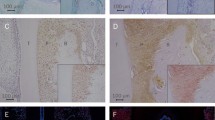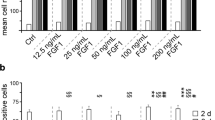Abstract.
The mechanism by which interleukin-1β (IL-1) inhibits the formation of mineralized tissue nodules by periodontal ligament (PDL) cells in vitro was investigated through the processes of morphological analysis, immunoprecipitation, and Northern blot analysis. PDL cells were obtained from a 2-day-old coagulum in tooth socket and cultured in Dulbecco's Modified Eagle Medium (DMEM) containing 10% fetal bone serum (FBS) and antibiotics. Confluent cells were grown for up to 3 weeks in the presence of ascorbic acid (AA), β-glycerophosphate (GP), and dexamethasone (Dex), or IL-1. PDL cells cultured in the presence of GP and AA did not differentiate, but those treated with Dex, GP, and AA (Dex group) underwent differentiation, showing four stages (confluent, multilayer, nodule, and mineralization) of disparate morphological characteristics. In contrast, the cells treated with IL-1, Dex, GP, and AA (IL-1 group) did form multilayers but failed to form mineralized nodules. Electron microscopy demonstrated that the Dex-induced mineralized nodules contain multilayers of fibroblastic cells, numerous collagen fibrils, and dense globular as well as fused electron dense patches that are associated with numerous apatite crystals. The nodule-like structures in the IL-1 group were also comprised of multilayered fibroblastic cells, but they contained only a small number of collagen fibrils, and no dense globular or fused patches. Von Kossa staining confirmed the presence of numerous mineralized nodules in the Dex group and their scarceness in the IL-1 group. Northern blot analysis of IL-1-treated cells, however, revealed the presence of mRNAs for type I collagen (Col I), secreted protein, acidic and rich in cysteine (SPARC), osteopontin (OPN), alkaline phosphatase (ALP), bone sialoprotein (BSP), and osteocalcin (OC), whose expression patterns and levels were comparable to those of the Dex group. Immunoprecipitation analysis of OPN and BSP in the cell/matrix layers and the culture media after [35S]-methionine labeling showed their deposition primarily in the mineralized nodules of the Dex group, and their release into the media in the IL-1 group. Immunogold labeling demonstrated the location of OPN and BSP in mineralized nodules of the Dex group, but no significant labeling occurred in the nodule-like structures from the IL-1 group. Interestingly, IL-1 treatment increased the expression of collagenase mRNA by sevenfold, compared with that of the Dex group. These data suggest that the IL-1-induced formation of unmineralized nodules by PDL cells results not so much from the downregulated formation of matrix proteins, which plays a crucial role in the mineralization process, as from their release into the culture media. Finally, collagenase synthesis upregulated by IL-1 may be involved in this process.
Similar content being viewed by others
Author information
Authors and Affiliations
Additional information
Received: 5 May 1998 / Accepted: 6 October 1998
Rights and permissions
About this article
Cite this article
Chien, HH., Lin, WL. & Cho, MI. Interleukin-1β—Induced Release of Matrix Proteins into Culture Media Causes Inhibition of Mineralization of Nodules Formed by Periodontal Ligament Cells In Vitro . Calcif Tissue Int 64, 402–413 (1999). https://doi.org/10.1007/PL00005822
Issue Date:
DOI: https://doi.org/10.1007/PL00005822




